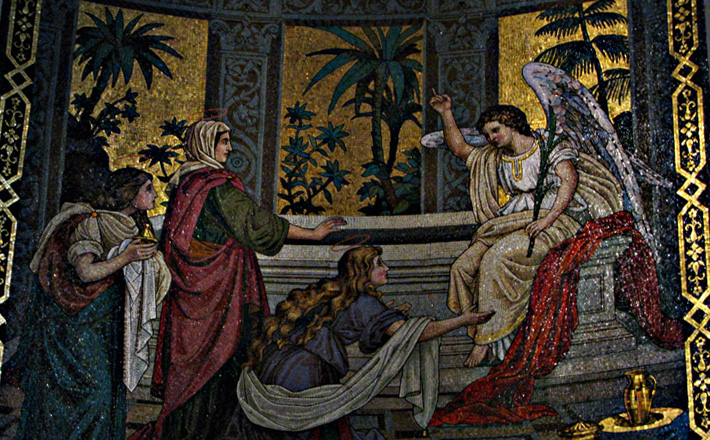Commentary on Matthew 28:1-10
We have to imagine our way into the moment described in this story.
For this day the preaching shoulders a proclamation of both ultimate folly and ultimate salvation. What the preacher must say today puts the preacher in the stead of the story’s angel who speaks to the women who have come to “see the tomb” — theorasai which means to watch, to observe, to hold vigil. The angel addresses Jesus’ followers who are drawn to be near the one they loved and had lost. This is true for the two Marys and for assemblies everywhere on the Day of the Resurrection.
The women experience Earth’s shaking (seismos). To them, the angel looks like lightning — a sizzling power, fraught with danger. Pivotal words like idou, translated as “suddenly” or “behold” or “look here” cannot convey the untranslatable truth that in this sequence of events, light has split a crack in the universe and everything we thought we knew is changed.
This story contains two such moments: “Suddenly … there was a great earthquake” and “Suddenly Jesus met them.” In other words, to meet Jesus is for the ground to move beneath you. Nothing remains as it was. This is the preaching to reach for, a heavy lifting whose aim is to stabilize whatever is in danger of faltering.
Consider two other images that fill the spaces between these “suddenlies.” One image is fear (phobos) — “for fear … the guards shook,” “Do not be afraid,” “they left with fear and joy.” The other image is vision (versions of orao and oida) — “come, see the place,” “you will see him,” “they will see me.” Even in what the angel says, “you are looking for Jesus,” the verb has the sense of seeking what was once in hand and is now lost. Looking for and yearning, fearing and seeing are entwined in the presence of the holy.
Perhaps we can hear in this construction from Matthew an assertion that we cannot see what is truly important without also experiencing fear. We cannot meet Jesus without being shaken. That these two human capacities are linked is evident in their being tied together in this crucial experience for Jesus’ followers. Even the word for “suddenly” has a visual quality. The thing that “appears” to the characters in this scene is as palpable, unmistakable, and fear-engendering as lightning
In our time, however, how do we speak of “seeing” to those whose vision is less than acute? What does this text say to the range of eyesight found among people? For some, even the outlines of guards lying stiff from fear might be too faint to identify. If the beloved teacher suddenly appeared, for some it may be impossible to locate his feet. Let us acknowledge the discomfort that exists when texts are heavily located in the capacity of the eyes. Let us hear beneath and behind the image to the point of the gospel: that witnessing Jesus’ resurrection represents a cataclysmic vision.
Utilizing Matthew’s language of seeing and fearing does honor to the Gospel writer, allowing the portrait offered by this moment to show us how faith is shaped. The promise the angel proclaims to the women is, in fact, an expansion of mere eyesight. It is to recognize and thereby to know the risen one in their — and our own — lives. The angels says that the risen one “is going ahead of you to Galilee; there you will see him.” The disciples will encounter the risen one. It is a promise that where Jesus’ disciples go, the risen one will meet us.
In addition to the promise of Christ Jesus’ presence, the angel’s message is about fear. “Do not be afraid.” In English, it sounds like a command and, as such, it is impossible to achieve. Fear simply rises in us when confronted with a threatening moment. The fear is physical; it takes the form of an adrenaline burst, makes the heart race, giving us the energy to flee for survival, if necessary. Over time, the stresses of fear take their toll in many maladies that wear down both physical strength and mental well-being.
What the angel says about fear is, however, not a command. The sense of “Do not be afraid” is not an emphatic requirement but a comforting assurance: There is nothing to fear. You need not fear. This calming voice comes from an authority who speaks with power that is beyond this world — a messenger who, the story tells us, rolled a huge stone, sat on it (a rather matter-of-fact posture, to be sure), shone like electricity, engendered such a sight that the guards swooned, and then had the audacity to tell the women there was nothing to fear. With no need for fear, the women are then instructed by the angel to move into their lives with swashbuckling abandon. We, too, are so instructed. Because God’s power has overturned all expectation in our world, we have nothing from which to coil into self-protection.
The women were still afraid, of course. Courage is not simply throwing caution to the wind, as they say, but action despite danger. Their fear, we can see, also now contains joy. For the preacher the challenge on this day is to stand with the angel, proclaiming the possibility of needing not to fear so that the assembly can move into the coming New Year with joy. There will be fear and joy. Why is this important? It was as the women left the tomb “with fear and great joy” to go find the other disciples that “Jesus met them … ”
The sermon on this day should propel the assembly to leave worship with both awe and celebratory power, eager to see where and how the risen one will meet them in their neighbors and friends, their prayer, their advocacy for what is good and just, and in their own gratitude for life and resurrection.


April 20, 2014